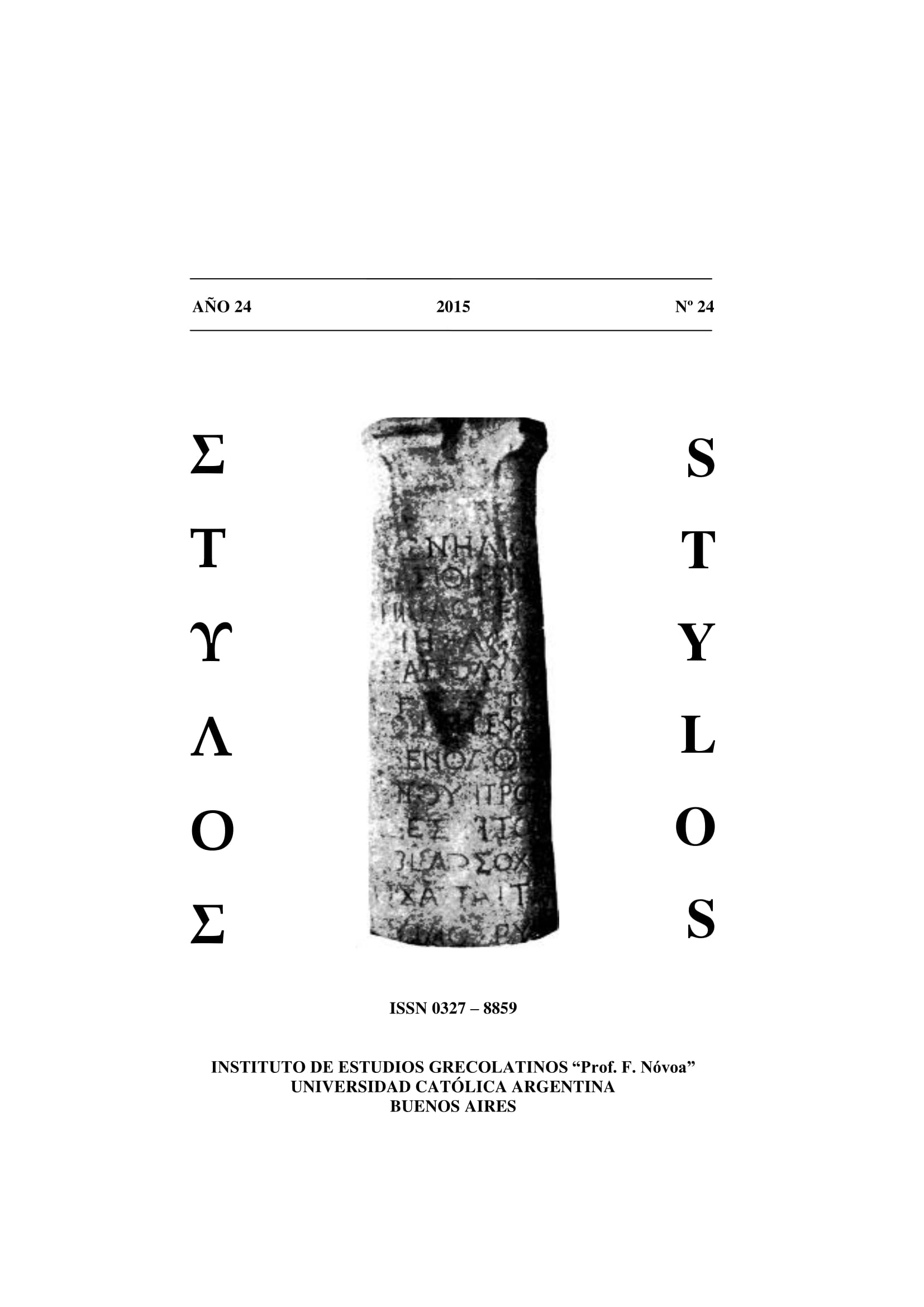LA METÁFRASIS BIZANTINA COMO FORMA DE INTRA-TRADUCCIÓN. EL CASO DE LA VIDA DE ESPIRIDÓN
Palabras clave:
hagiografía – Leoncio de Neápolis – metáfrasis – traducción – BizancioResumen
El presente trabajo estudia el caso de la Vida de Espiridón, que atribuimos a Leoncio de Neápolis, y otras versiones del texto que constituyen ‘metáfrasis’. Se propone el concepto de ‘intra-traducción’ para la labor que implica poner en un nivel de lengua accesible a un mayor público aquello que resultaba ‘difícil’ por su altura lingüística, retórica o poética, pero no pasar un texto de un código a otro, de una lengua a otra. Mas aquí se analiza como ‘intra-traducción a la inversa’ la obra de Leoncio y sus adaptaciones, porque éstas intentan hacer más literario y culto el nivel de lengua del original. Este tipo de tareas es una ‘adaptación’, ‘reelaboración’ o ‘recreación’ más que una traducción, tarea de un reelaborador que, al interior de una misma lengua, hace modificaciones que tienen que ver con el estilo, la intencionalidad y, quizás, la ideología.Descargas
Citas
BÁDENAS, P. (1996): “Metáfrasis en griego vulgar de la Historia de Barlaam e Josafat”, en J. Egea-J. Alonso eds. Prosa y verso en griego medieval, Amsterdam, Hakkert, 59-73.
BRIESEMEISTER, D. (1980): “Die Theorie der Übersetzung in Spanien im 15.Jahrhundert”, en Stimmen der Romania, Wiesbaden, 483-517.
BROWN, P. (1983): “The saint as exemplar in Late Antiquity”, Representations 3, 1-25.
BROWNING, R. (1981): “The ‘low level’ saint’s life in the early Byzantine world”, en S. Hackel ed. The Byzantine saint, London, Saint Vladimir Seminary Press, 117-127.
CAPES, D. (2003): “Imitatio Christi and the Gospel genre”, Bulletin for biblical research 13/1, 1-19.
CAVALLERO, P. (1986): "La adaptación poética de los Moralia in Iob de San Gregorio en el Rimado de Palacio del Canciller Ayala", Hispania Sa-cra 38, 401-518.
CAVALLERO, P. (1991): Del soberano bien": romanceamiento castellano medieval de las "Sententiae" de San Isidoro, edición crítica con intro-ducción y notas. Buenos Aires, SECRIT-CONICET (Incipit, Publica-ciones 3).
CAVALLERO, P. (2008): “El griego en el latín de Liutprando, el latín en el griego de Leoncio”, en A. Fraboschi ed. Grecia en la Latinidad: actas de las XIV Jornadas de Estudios Clásicos, Buenos Aires, Instituto Nó-voa, UCA, 2008, 71-80.
CAVALLERO, P.-FERNÁNDEZ, T.-LASTRA SHERIDAN, J. (2009): LEONCIO DE NEÁPOLIS, Vida de Simeón el loco, edición revisada, con introducción, traducción y notas Buenos Aires, Sección Filología Medieval del Instituto de Filología Clásica, FFyL, UBA.
CAVALLERO, P. -UBIERNA, P. et alii (2011): LEONCIO DE NEÁPOLIS, Vida de Juan el limosnero, edición revisada, con introducción, traducción y notas por P. Cavallero, P. Ubierna, A. Capboscq, J. Lastra Sheridan, A. Sapere, T. Fernández, S. Bohdziewicz y D. Santos. Buenos Aires, Sección Filología Medieval del Instituto de Filología Clásica, FFyL, UBA.
CHANTRAINE, P. (1999): Dictionnaire étymologique de la langue grecque, avec un supplément, Paris, Klincksieck.
DELAVENAY, É. (1972): La machine à traduire, Paris, PUF, 3e. éd.
DELEHAYE, H. (1927): “Une vie inédite de saint Jean l’Aumônier”, Analecta Bollandiana 45, 5-74.
DIMITRAKOS, D. (1951): Méga léxikon ólis tis ellinikís glóssis, Athinai, Domi.
DU CANGE, Charles du Fresne Sgr. Glassarium ad scriptores mediae et infi-mae graecitatis, Lugduni, Anissonius-Posuel-Rigaud, 1668 = Graz, 1958.
EFTHYMIADIS, S. (1991): “John of Sardis and the metaphrasis of the Passio of St. Nikephoros the martyr (BHG 1334)”, Rivista di studi bizantini e neoellenici 28, 23-44.
EFTHYMIADIS, S. (2006): “Two Gregories and three genres: autobiography, autohagiography and hagiography”, en J. Bortnes-T. Hägg edd. Gregory of Nazianzus: images and reflections, Copenhagen, Museum Tusculanum Press, 239-256.
EFTHYMIADIS, S. (2011): “Hagiography from the ‘Dark Age’ to the age of Symeon Metaphrastes (eight-tenth centuries)”, en The Ashgate re-search companion to Byzantine hagiography, vol. I, Farnham-Surrey, Ashgate, 95-142.
EHRHARD, A. (1928): reseña “H. Delehaye, Une vie inédite de Saint Jean l'au-mônier. Anal. Boll. 45 (1927) 5-74“, BZ 28, 440-441.
ERNOUT, A. - MEILLET, A. (1951): Dictionnaire étymologique de la langue latine. Histoire des mots, Paris, Klincksieck, 3e. édition.
FESTUGIERE, A.-RYDEN, L. (1974): Léontios de Néapolis, Vie de Syméon le fou et Vie de Jean de Chypre, Paris, Paul Geuthner.
GOUILLARD, J. (1941): “Syméon Logothète et Magistros, surnommé Méta-phrastes”, Dictionnaire de théologie catholique 14/2, 2959-2972.
HǾGEL, Ch. (1996): ed. Metaphrasis: redactions and audiences in Middle Byzantine hagiography, Oslo.
HǾGEL, Ch. (2002): Symeon Metaphrastes. Rewriting and canonization, Co-penhagen.
HORTAL, A. (2007): Ética profesional de traductores e intérpretes, Bilbao, Desclée de Brouwer.
JAKOBSON, R. (1975): “En torno a los aspectos lingüísticos de la traducción”, en Ensayos de lingüística general, Barcelona, Seix Barral, 67-77.
KRIARAS, E. (1971-): Λεξικό της μεσαιωνικής ελληνικής δημώδους γραμματείας 1100-1669, Tessaloniki.
LAFONTAINE, G. (1973): “Une vie grecque abrégée de saint Grégoire l’illuminateur (cod. Sin. Gr. 376)”, Le muséon 86, 135-145.
LAMPE, W. (1961): A patristic Greek lexicon, Oxford, Clarendon.
LAPPA-ZIZICAS, E. (1970): “Une épitomé de la vie de S. Jean l’Aumônier par Jean et Sophronius”, Analecta Bollandiana 88, 265-278.
LESPÉRAS, J. (1980): “La traduction et ses théories en Espagne au XVe et XVIe siècles”, Revue des langues romanes 84, 81-92.
MAGDALINO, P. (1999): “’What we heard in the Lives of the saints we have seen with our own eyes’: the holy man as literary text in tenth century Constantinople”, en J. Howard-Johnston- P. Hayward, The cult of the Saints in Late Antiquity and the Middle ages. Essays on the contribution of Peter Brown, Oxford, 83-112.
MANGO, C. (1994): “El Santo”, en G. Cavallo (comp.) El hombre bizantino, Madrid, Alianza, 319-350.
MARGOT, J. (1987): Traducir sin traicionar, Madrid, Cristiandad.
MERINO, W. (1983): “Traduttore traditore: riesgos y peligros de la traducción”, Estudios humanísticos 5, 39-54.
MONFRIN, J. (1964): “Humanisme et traducteurs au Moyen Âge”, en L’humanisme médiéval dans les littératures romanes du XIIe au XIVe siècle (Colloque Strasboug 1962), Paris, vol. 3, 217-246.
MOUNIN, G. (1977): Los problemas teóricos de la traducción, Madrid, Gre-dos, 2ª ed.
PASCHALIDIS, S. (2011): “The hagiography of eleventh and twelfth centu-ries”, en S. Efthymiadis, The Ashgate research companion to Byzan-tine hagiography, vol. I, Farnham-Surrey, Ashgate, 143-171.
PASSOW, F. (1848): A Greek-English lexicon based on the work of Francis Passow, by H. Liddell, R. Scott and H. Drisler, New York, Harper and brothers.
PEYR, E. (1992): “Zur Umarbeitung rhetorischer Texte durch Symeon Metaphrastes”, Jahrbuch der Österreichischen Byzantinistik 42, 143-155.
RAPP, C. (1995): "Byzantine hagiographers as antiquarians. Seventh to tenth centuries“, Byzantinische Forschungen 21, 33-44.
SÁEZ HERMOSILLA, T. (1980): “Pratique et théorie de la traduction”, Anua-rio de estudios filológicos 3, 203-213.
SIMPSON, A. (2013): Niketas Choniates. A historiograpjical study, Oxford, University Press.
SOPHOCLÉS, E. (1887): Greek lexicon of the Roman and Byzantine periods, Hildesheim-Zürich-New York, Georg Olms Verlag, 1992.
STEPHANUS, H. (1842-1846): Thesaurus Graecae Linguae, Paris, Didot.
STEPHOU, L. (2011): Die neugriechische Metaphrase von Stephanites und Ichnelates durch Theodosios Zygomalas, Madrid, CSIC.
STEINER, G. (1980): Después de Babel. Aspectos del lenguaje y la traducción, México, FCE.
TALBOT, A. (2011): “Hagiography in late Byzantium (1204-1453)”, en S. Efthymiadis ed. The Ashgate research companion to Byzantine hagiography, vol. I, Farnham-Surrey, Ashgate, 173-195.
TERRACINI, B. (1951): “El problema de la traducción”, en Conflictos de len-guas y de cultura, Buenos Aires, Imán, 43-103.
THÉRY, G. (1950): “Notes indicatrices pour s’orienter dans l’étude des tra-ductions médiévales”, en Mélanges Joseph Maréchal, 2: Hommages, Museum Lessianum, Section philosophique Nº 32, Bruxelles-Paris, 297-315.
TOUFEXIS, N. (2008): “Diglossia and register variation in Medieval Greek“, Byzantine and Modern Greek Studies 32/2, 203–217.
TRAPP, E. (2001): Lexicon zur byzantinistischen Gräzität, besonders des 9.-12. Jahrhunderts, Band A-K, Wien, Österreichischen Akademie der Wissenschaften.
VAN DEN VEN, P. (1953): La légende de S. Spyridon, évêque de Trimithonte, Louvain, Institut orientaliste.
VOLK, R. (2002): “Eine seltsame Metaphrase von Psellos-Briefe”, JÖB 52, 185-196.
WEST, C. (1932): “La théorie de la traduction au XVIIIe siècle”, Revue de littérature comparée XII, 330-352.
ZILLIACUS, H. (1938): “Zur stilistischen Umarbeitungstechnik des Symeon Metaphrastes”, BZ 38, 333-350.
Descargas
Publicado
Cómo citar
Número
Sección
Licencia






